Steric Quenching of Mn(III) Thermal Spin Crossover: Dilution of Spin Centers in Immobilized Solutions
Abstract
:1. Introduction
2. Results and Discussion
2.1. Synthetic Route to Complexes (1)–(12)
2.2. Magnetic Characterisation of Complexes (1)–(12)
2.3. Structural Characterisation of Non-Alkylated SCO Complexes (1)–(5)
2.4. Structural Characterisation of Alkylated SCO Complexes (6)–(12)
2.5. Raman Spectra of Alkylated Complexes (10)–(12)
3. Conclusions
4. Materials and Methods
4.1. General Experimental Details
4.2. Synthesis and Characterisation of Non-Alkylated Complexes 1–5
4.3. Synthesis and Characterisation of Complexes 6–9 with 4,6-diOMe-sal2323-Cn Alkylated Ligands
4.4. Synthesis and Characterisation of Complexes 10–12 with 3-OMe-sal2323-Cn Alkylated Ligands
Supplementary Materials
Author Contributions
Funding
Institutional Review Board Statement
Informed Consent Statement
Data Availability Statement
Conflicts of Interest
References
- Murray, K.S.; Kepert, C.J. Cooperativity in spin crossover systems: Memory, magnetism and microporosity. In Spin Crossover in Transition Metal Compounds I; Gütlich, P., Goodwin, H.A., Eds.; Springer: Berlin/Heidelberg, Germany, 2004; pp. 195–228. [Google Scholar] [CrossRef]
- Hogue, R.W.; Singh, S.; Brooker, S. Spin crossover in discrete polynuclear Iron(II) complexes. Chem. Soc. Rev. 2018, 47, 7303–7338. [Google Scholar] [CrossRef] [Green Version]
- Ni, Z.-P.; Liu, J.-L.; Hoque, M.N.; Liu, W.; Li, J.-Y.; Chen, Y.-C.; Tong, M.-L. Recent advances in guest effects on spin-crossover behavior in Hofmann-type metal-organic frameworks. Coord. Chem. Rev. 2017, 335, 28–43. [Google Scholar] [CrossRef]
- Barker, A.; Kelly, C.T.; Kühne, I.A.; Hill, S.; Krzystek, J.; Wix, P.; Esien, K.; Felton, S.; Müller-Bunz, H.; Morgan, G.G. Spin state solvomorphism in a series of rare S = 1 manganese(III) complexes. Dalton Trans. 2019, 48, 15560–15566. [Google Scholar] [CrossRef]
- Banerjee, H.; Chakraborty, S.; Saha-Dasgupta, T. Design and control of cooperativity in spin-crossover in metal–organic complexes: A theoretical overview. Inorganics 2017, 5, 47. [Google Scholar] [CrossRef] [Green Version]
- Busch, R.; Carter, A.B.; Konidaris, K.F.; Kühne, I.A.; González, R.; Anson, C.E.; Powell, A.K. The first use of a ReX5 synthon to modulate FeIII spin crossover via supramolecular halogen⋅⋅⋅Halogen Interactions. Chemistry 2020, 26, 11835–11840. [Google Scholar] [CrossRef]
- Pandurangan, K.; Gildea, B.; Murray, C.; Harding, C.J.; Müller-Bunz, H.; Morgan, G.G. Lattice effects on the spin-crossover profile of a mononuclear Manganese(III) cation. Chemistry 2012, 18, 2021–2029. [Google Scholar] [CrossRef]
- Gildea, B.; Harris, M.M.; Gavin, L.C.; Murray, C.A.; Ortin, Y.; Müller-Bunz, H.; Harding, C.J.; Lan, Y.; Powell, A.K.; Morgan, G.G. Substituent effects on spin state in a series of mononuclear Manganese(III) complexes with hexadentate schiff-base ligands. Inorg. Chem. 2014, 53, 6022–6033. [Google Scholar] [CrossRef] [PubMed]
- Kühne, I.A.; Gavin, L.C.; Harris, M.; Gildea, B.; Müller-Bunz, H.; Stein, M.; Morgan, G.G. Mn(III) complexes with nitro-substituted ligands—Spin states with a twist. J. Appl. Phys. 2021, 129, 213903. [Google Scholar] [CrossRef]
- Gildea, B.; Gavin, L.C.; Murray, C.A.; Müller-Bunz, H.; Harding, C.J.; Morgan, G.G. Supramolecular modulation of spin crossover profile in manganese(III). Supramol. Chem. 2012, 24, 641–653. [Google Scholar] [CrossRef]
- Kühne, I.A.; Esien, K.; Gavin, L.C.; Müller-Bunz, H.; Felton, S.; Morgan, G.G. Modulation of Mn3+ spin state by guest molecule inclusion. Molecules 2020, 25, 5603. [Google Scholar] [CrossRef] [PubMed]
- Kühne, I.A.; Barker, A.; Zhang, F.; Stamenov, P.; O’Doherty, O.; Müller-Bunz, H.; Stein, M.; Rodriguez, B.J.; Morgan, G.G. Modulation of Jahn–Teller distortion and electromechanical response in a Mn3+ spin crossover complex. J. Phys. Condens. Matter 2020, 32, 404002. [Google Scholar] [CrossRef]
- Harding, D.J.; Harding, P.; Phonsri, W. Spin crossover in Iron(III) complexes. Coord. Chem. Rev. 2016, 313, 38–61. [Google Scholar] [CrossRef]
- Halcrow, M.A. Structure: Function relationships in molecular spin-crossover complexes. Chem. Soc. Rev. 2011, 40, 4119–4142. [Google Scholar] [CrossRef] [PubMed]
- Tweedle, M.F.; Wilson, L.J. Variable spin Iron(III) chelates with hexadentate ligands derived from triethylenetetramine and various salicylaldehydes. Synthesis, characterization, and solution state studies of a new 2T.dblarw. 6A spin equilibrium system. J. Am. Chem. Soc. 1976, 98, 4824–4834. [Google Scholar] [CrossRef]
- Conti, A.J.; Chadha, R.K.; Sena, K.M.; Rheingold, A.L.; Hendrickson, D.N. Dynamics and phase transitions in spin-crossover complexes: X-ray structures and basic crossover phenomena in the solvate series bis(3-ethoxysalicylideneaziridinopropylaminato)iron perchlorate.solvate. Inorg. Chem. 1993, 32, 2670–2680. [Google Scholar] [CrossRef]
- Real, J.A.; Gaspar, A.B.; Niel, V.; Muñoz, M.C. Communication between Iron(II) building blocks in cooperative spin transition phenomena. Coord. Chem. Rev. 2003, 236, 121–141. [Google Scholar] [CrossRef]
- Hostettler, M.; Törnroos, K.W.; Chernyshov, D.; Vangdal, B.; Bürgi, H.-B. Challenges in engineering spin crossover: Structures and magnetic properties of six alcohol solvates of Iron(II) Tris(2-picolylamine) dichloride. Angew. Chem. Int. Ed. 2004, 43, 4589–4594. [Google Scholar] [CrossRef]
- Quesada, M.; Prins, F.; Bill, E.; Kooijman, H.; Gamez, P.; Roubeau, O.; Spek, A.L.; Haasnoot, J.G.; Reedijk, J. Counterion effect on the spin-transition properties of the cation [Fe(btzx)3]2+ (btzx=m-Xylylenebis(tetrazole)). Chemistry 2008, 14, 8486–8499. [Google Scholar] [CrossRef] [Green Version]
- Yamada, M.; Hagiwara, H.; Torigoe, H.; Matsumoto, N.; Kojima, M.; Dahan, F.; Tuchagues, J.-P.; Re, N.; Iijima, S. A variety of spin-crossover behaviors depending on the counter anion: Two-dimensional complexes constructed by NH⋅⋅⋅Cl− Hydrogen Bonds, [FeIIH3LMe]Cl·X (X = PF6−, AsF6−, SbF6−, CF3SO3−; H3LMe = Tris[2 -{[(2-methylimidazol-4-yl)methylidene]amino}ethyl]amine). Chemistry 2006, 12, 4536–4549. [Google Scholar] [CrossRef]
- Halcrow, M.A. Iron(II) complexes of 2,6-di(pyrazol-1-yl)pyridines—A versatile system for spin-crossover research. Coord. Chem. Rev. 2009, 253, 2493–2514. [Google Scholar] [CrossRef]
- Scott, H.S.; Staniland, R.W.; Kruger, P.E. Spin crossover in homoleptic Fe(II) imidazolylimine complexes. Coord. Chem. Rev. 2018, 362, 24–43. [Google Scholar] [CrossRef]
- Xue, S.; Rotaru, A.; Garcia, Y. Ligand field strength tuning in the model [Fe(H2Bpz2)2(bipy)] spin crossover complex. Hyperfine Interact. 2019, 240, 91. [Google Scholar] [CrossRef]
- Boča, R.; Renz, F.; Boča, M.; Fuess, H.; Haase, W.; Kickelbick, G.; Linert, W.; Vrbová-Schikora, M. Tuning the spin crossover above room temperature: Iron(II) complexes of substituted and deprotonated 2,6-bis(benzimidazol-2-yl)pyridine. Inorg. Chem. Commun. 2005, 8, 227–230. [Google Scholar] [CrossRef]
- Deorukhkar, N.; Besnard, C.; Guénée, L.; Piguet, C. Tuning spin-crossover transition temperatures in non-symmetrical homoleptic meridional/facial [Fe(didentate)3]2+ complexes: What for and who cares about it? Dalton Trans. 2021, 50, 1206–1223. [Google Scholar] [CrossRef] [PubMed]
- Palion-Gazda, J.; Machura, B.; Kruszynski, R.; Grancha, T.; Moliner, N.; Lloret, F.; Julve, M. Spin crossover in double salts containing six- and four-coordinate Cobalt(II) ions. Inorg. Chem. 2017, 56, 6281–6296. [Google Scholar] [CrossRef] [PubMed]
- Galet, A.; Gaspar, A.B.; Muñoz, M.C.; Real, J.A. Influence of the counterion and the solvent molecules in the spin crossover system [Co(4-terpyridone)2]Xp·nH2O. Inorg. Chem. 2006, 45, 4413–4422. [Google Scholar] [CrossRef] [PubMed]
- Palion-Gazda, J.; Świtlicka-Olszewska, A.; Machura, B.; Grancha, T.; Pardo, E.; Lloret, F.; Julve, M. High-temperature spin crossover in a mononuclear six-coordinate Cobalt(II) complex. Inorg. Chem. 2014, 53, 10009–10011. [Google Scholar] [CrossRef]
- Judge, J.S.; Baker, W.A. Magnetic and spectral studies of some anomolous Mono-(2,2′,2″,-terpyridine) complexes of Co(II) and Ni(II). Inorg. Chim. Acta 1967, 1, 245–248. [Google Scholar] [CrossRef]
- Weber, B.; Bauer, W.; Obel, J. An Iron(II) spin-crossover complex with a 70 K wide thermal hysteresis loop. Angew. Chem. Int. Ed. 2008, 47, 10098–10101. [Google Scholar] [CrossRef]
- Weber, B.; Obel, J.; Henner-Vásquez, D.; Bauer, W. Two new Iron(II) spin-crossover complexes with N4O2 coordination sphere and spin transition around room temperature. Eur. J. Inorg. Chem. 2009, 2009, 5527–5534. [Google Scholar] [CrossRef]
- Li, B.; Wei, R.-J.; Tao, J.; Huang, R.-B.; Zheng, L.-S.; Zheng, Z. Solvent-Induced transformation of single crystals of a spin-crossover (SCO) compound to single crystals with two distinct SCO centers. J. Am. Chem. Soc. 2010, 132, 1558–1566. [Google Scholar] [CrossRef]
- Halcrow, M.A.; Capel Berdiell, I.; Pask, C.M.; Kulmaczewski, R. Relationship between the molecular structure and switching temperature in a library of spin-crossover molecular materials. Inorg. Chem. 2019, 58, 9811–9821. [Google Scholar] [CrossRef]
- Létard, J.-F.; Guionneau, P.; Codjovi, E.; Lavastre, O.; Bravic, G.; Chasseau, D.; Kahn, O. Wide thermal hysteresis for the mononuclear spin-crossover compound cis-bis(thiocyanato)bis[N-(2′-pyridylmethylene)-4-(phenylethynyl)anilino]Iron(II). J. Am. Chem. Soc. 1997, 119, 10861–10862. [Google Scholar] [CrossRef]
- Hagiwara, H.; Hashimoto, S.; Matsumoto, N.; Iijima, S. Two-dimensional Iron(II) spin crossover complex constructed of bifurcated NH···O− hydrogen bonds and π−π interactions: [FeII(HLH,Me)2](ClO4)2·1.5MeCN (HLH,Me = Imidazol-4-yl-methylidene-8-amino-2-methylquinoline). Inorg. Chem. 2007, 46, 3136–3143. [Google Scholar] [CrossRef] [PubMed]
- Zhong, Z.J.; Tao, J.-Q.; Yu, Z.; Dun, C.-Y.; Liu, Y.-J.; You, X.-Z. A stacking spin-crossover Iron(II) compound with a large hysteresis. J. Chem. Soc. Dalton Trans. 1998, 327–328. [Google Scholar] [CrossRef]
- Pfaffeneder, T.M.; Thallmair, S.; Bauer, W.; Weber, B. Complete and incomplete spin transitions in 1D chain Iron(II) compounds. New J. Chem. 2011, 35, 691–700. [Google Scholar] [CrossRef] [Green Version]
- Zhang, W.; Zhao, F.; Liu, T.; Yuan, M.; Wang, Z.-M.; Gao, S. Spin crossover in a Series of Iron(II) complexes of 2-(2-Alkyl-2H-tetrazol-5-yl)-1,10-phenanthroline: Effects of alkyl side chain, solvent, and anion. Inorg. Chem. 2007, 46, 2541–2555. [Google Scholar] [CrossRef]
- Hayami, S.; Danjobara, K.; Shigeyoshi, Y.; Inoue, K.; Ogawa, Y.; Maeda, Y. Crystal structure and mesogenic property of an Iron(II) complex with a terpyridine derivative ligand. Inorg. Chem. Commun. 2005, 8, 506–509. [Google Scholar] [CrossRef]
- Scott, H.S.; Moubaraki, B.; Paradis, N.; Chastanet, G.; Létard, J.-F.; Batten, S.R.; Murray, K.S. 2,2′-Dipyridylamino-based ligands with substituted alkyl chain groups and their mononuclear-M(II) spin crossover complexes. J. Mater. Chem. C 2015, 3, 7845–7857. [Google Scholar] [CrossRef]
- Ueno, S.; Kawasaki, T.; Okabayashi, J.; Kitazawa, T. 2D spin-crossover coordination polymer Fe(hexyl-nicotinate)2[Au(CN)2]2. Bull. Chem. Soc. Jpn. 2016, 89, 581–583. [Google Scholar] [CrossRef]
- Seredyuk, M.; Gaspar, A.B.; Ksenofontov, V.; Galyametdinov, Y.; Kusz, J.; Gütlich, P. Does the solid−liquid crystal phase transition provoke the spin-state change in spin-crossover metallomesogens? J. Am. Chem. Soc. 2008, 130, 1431–1439. [Google Scholar] [CrossRef]
- Seredyuk, M. Iron(II) metallomesogens based on symmetrical tripod ligands. Inorg. Chim. Acta 2012, 380, 65–71. [Google Scholar] [CrossRef]
- Seredyuk, M.; Gaspar, A.B.; Ksenofontov, V.; Galyametdinov, Y.; Kusz, J.; Gütlich, P. Iron(II) metallomesogens exhibiting coupled spin state and liquid crystal phase transitions near room temperature. Adv. Funct. Mater. 2008, 18, 2089–2101. [Google Scholar] [CrossRef]
- Vologzhanina, A.V.; Belov, A.S.; Novikov, V.V.; Dolganov, A.V.; Romanenko, G.V.; Ovcharenko, V.I.; Korlyukov, A.A.; Buzin, M.I.; Voloshin, Y.Z. Synthesis and temperature-induced structural phase and spin transitions in hexadecylboron-capped Cobalt(II) hexachloroclathrochelate and its diamagnetic Iron(II)-encapsulating analogue. Inorg. Chem. 2015, 54, 5827–5838. [Google Scholar] [CrossRef] [PubMed]
- Voloshin, Y.Z.; Varzatskii, O.A.; Stash, A.I.; Belsky, V.K.; Bubnov, Y.N.; Vorontsov, I.I.; Potekhin, K.A.; Antipin, M.Y.; Polshin, E.V. Template synthesis, structure and unusual series of phase transitions in clathrochelate Iron(II) α-dioximates and oximehydrazonates formed by capping with functionalized boron-containing agents. Polyhedron 2001, 20, 2721–2733. [Google Scholar] [CrossRef]
- Han, W.-K.; Li, Z.-H.; Zhu, W.; Li, T.; Li, Z.; Ren, X.; Gu, Z.-G. Molecular isomerism induced Fe(II) spin state difference based on the tautomerization of the 4(5)-methylimidazole group. Dalton Trans. 2017, 46, 4218–4224. [Google Scholar] [CrossRef]
- Kitchen, J.A.; White, N.G.; Jameson, G.N.L.; Tallon, J.L.; Brooker, S. Effect of counteranion X on the spin crossover properties of a family of Diiron(II) triazole complexes [FeII2(PMAT)2](X)4. Inorg. Chem. 2011, 50, 4586–4597. [Google Scholar] [CrossRef]
- Schlamp, S.; Weber, B.; Naik, A.D.; Garcia, Y. Cooperative spin transition in a lipid layer like system. Chem. Commun. 2011, 47, 7152–7154. [Google Scholar] [CrossRef] [PubMed] [Green Version]
- Schlamp, S.; Thoma, P.; Weber, B. New octahedral, head–tail Iron(II) complexes with spin crossover properties. Eur. J. Inorg. Chem. 2012, 2012, 2759–2768. [Google Scholar] [CrossRef]
- Schlamp, S.; Dankhoff, K.; Weber, B. Amphiphilic Iron(II) complexes with short alkyl chains–crystal packing and spin transition properties. New J. Chem. 2014, 38, 1965–1972. [Google Scholar] [CrossRef]
- Schlamp, S.; Lochenie, C.; Bauer, T.; Kempe, R.; Weber, B. Iron(II) spin-crossover complexes with schiff base like ligands and N-alkylimidazoles. Eur. J. Inorg. Chem. 2015, 2015, 408–413. [Google Scholar] [CrossRef]
- Schlamp, S.; Thoma, P.; Weber, B. Influence of the alkyl chain length on the self-assembly of amphiphilic iron complexes: An analysis of X-ray structures. Chemistry 2014, 20, 6462–6473. [Google Scholar] [CrossRef]
- Martinho, P.N.; Ortin, Y.; Gildea, B.; Gandolfi, C.; McKerr, G.; O’Hagan, B.; Albrecht, M.; Morgan, G.G. Inducing hysteretic spin crossover in solution. Dalton Trans. 2012, 41, 7461–7463. [Google Scholar] [CrossRef] [PubMed]
- Martinho, P.N.; Kühne, I.A.; Gildea, B.; McKerr, G.; O’Hagan, B.; Keyes, T.E.; Lemma, T.; Gandolfi, C.; Albrecht, M.; Morgan, G.G. Self-assembly properties of amphiphilic Iron(III) spin crossover complexes in water and at the air–water interface. Magnetochemistry 2018, 4, 49. [Google Scholar] [CrossRef] [Green Version]
- Gandolfi, C.; Moitzi, C.; Schurtenberger, P.; Morgan, G.G.; Albrecht, M. Improved cooperativity of spin-labile iron(III) centers by self-assembly in solution. J. Am. Chem. Soc. 2008, 130, 14434–14435. [Google Scholar] [CrossRef] [PubMed] [Green Version]
- Gandolfi, C.; Morgan, G.G.; Albrecht, M. A magnetic iron(III) switch with controlled and adjustable thermal response for solution processing. Dalton Trans. 2012, 41, 3726–3730. [Google Scholar] [CrossRef] [PubMed] [Green Version]
- Martinho, P.N.; Harding, C.J.; Müller-Bunz, H.; Albrecht, M.; Morgan, G.G. Inducing spin crossover in amphiphilic iron(III) complexes. Eur. J. Inorg. Chem. 2010, 2010, 675–679. [Google Scholar] [CrossRef] [Green Version]
- Gandolfi, C.; Miyashita, N.; Kurth, D.G.; Martinho, P.N.; Morgan, G.G.; Albrecht, M. Organization of spin- and redox-labile metal centers into Langmuir and Langmuir–Blodgett films. Dalton Trans. 2010, 39, 4508–4516. [Google Scholar] [CrossRef] [Green Version]
- Nakaya, M.; Shimayama, K.; Takami, K.; Hirata, K.; Amolegbe, S.A.; Nakamura, M.; Lindoy, L.F.; Hayami, S. Structures and magnetic properties of Iron(III) complexes with long alkyl chains. Crystals 2014, 4, 104. [Google Scholar] [CrossRef] [Green Version]
- Martinho, P.N.; Lemma, T.; Gildea, B.; Picardi, G.; Müller-Bunz, H.; Forster, R.J.; Keyes, T.E.; Redmond, G.; Morgan, G.G. Template assembly of spin crossover one-dimensional nanowires. Angew. Chem. Int. Ed. 2012, 51, 11995–11999. [Google Scholar] [CrossRef]
- Johnson, C.J.; Morgan, G.G.; Albrecht, M. Predictable adjustment of spin crossover temperature in solutions of Iron(III) complexes functionalized with alkyl-urea tails. J. Mater. Chem. C 2015, 3, 7883–7889. [Google Scholar] [CrossRef]
- Fitzpatrick, A.J.; Martinho, P.N.; Gildea, B.J.; Holbrey, J.D.; Morgan, G.G. Robust room temperature hysteresis in an FeIII spin crossover metallomesogen. Eur. J. Inorg. Chem. 2016, 2016, 2025–2029. [Google Scholar] [CrossRef] [Green Version]
- Gandolfi, C.; Cotting, T.; Martinho, P.N.; Sereda, O.; Neels, A.; Morgan, G.G.; Albrecht, M. Synthesis and self-assembly of spin-labile and redox-active Manganese(III) complexes. Dalton Trans. 2011, 40, 1855–1865. [Google Scholar] [CrossRef] [PubMed] [Green Version]
- Carter, A.B.; Laverick, R.J.; Wales, D.J.; Akponasa, S.O.; Scott, A.J.; Keene, T.D.; Kitchen, J.A. Investigating the structure directing properties of designer 1,8-naphthalimide and amphiphilic sulfonate anions and their FeIII thiosemicarbazone complexes. Cryst. Growth Des. 2017, 17, 5129–5144. [Google Scholar] [CrossRef] [Green Version]
- Kitchen, J.A.; White, N.G.; Gandolfi, C.; Albrecht, M.; Jameson, G.N.L.; Tallon, J.L.; Brooker, S. Room-temperature spin crossover and Langmuir–Blodgett film formation of an Iron(II) triazole complex featuring a long alkyl chain substituent: The tail that wags the dog. Chem. Commun. 2010, 46, 6464–6466. [Google Scholar] [CrossRef] [PubMed]
- Feltham, H.L.C.; Johnson, C.; Elliott, A.B.S.; Gordon, K.C.; Albrecht, M.; Brooker, S. “Tail” tuning of Iron(II) spin crossover temperature by 100 K. Inorg. Chem. 2015, 54, 2902–2909. [Google Scholar] [CrossRef] [PubMed]
- Soyer, H.; Dupart, E.; Gómez-García, C.J.; Mingotaud, C.; Delhaès, P. First magnetic observation of a spin crossover in a Langmuir–Blodgett film. Adv. Mater. 1999, 11, 382–384. [Google Scholar] [CrossRef]
- Ketkaew, R.; Tantirungrotechai, Y.; Harding, P.; Chastanet, G.; Guionneau, P.; Marchivie, M.; Harding, D.J. OctaDist: A tool for calculating distortion parameters in spin crossover and coordination complexes. Dalton Trans. 2021, 50, 1086–1096. [Google Scholar] [CrossRef]
- Barrett, S.A.; Halcrow, M.A. Anion-dependent spin crossover in solution for an Iron(II) complex of a 1H-pyrazolyl ligand. RSC Adv. 2014, 4, 11240–11243. [Google Scholar] [CrossRef]
- De, S.; Tewary, S.; Garnier, D.; Li, Y.; Gontard, G.; Lisnard, L.; Flambard, A.; Breher, F.; Boillot, M.-L.; Rajaraman, G.; et al. Solution and solid-state study of the spin-crossover [FeII(R-bik)3](BF4)2 complexes (R = Me, Et, Vinyl). Eur. J. Inorg. Chem. 2018, 2018, 414–428. [Google Scholar] [CrossRef] [Green Version]
- Chastanet, G.; Lorenc, M.; Bertoni, R.; Desplanches, C. Light-induced spin crossover—Solution and solid-state processes. Comptes Rendus Chim. 2018, 21, 1075–1094. [Google Scholar] [CrossRef]
- Rodríguez-Jiménez, S.; Brooker, S. Solid versus solution spin crossover and the importance of the Fe-N≡C(X) angle. Inorg. Chem. 2017, 56, 13697–13708. [Google Scholar] [CrossRef] [PubMed]
- Weber, B.; Walker, F.A. Solution NMR studies of Iron(II) spin-crossover complexes. Inorg. Chem. 2007, 46, 6794–6803. [Google Scholar] [CrossRef] [PubMed]
- Forshaw, A.P.; Smith, J.M.; Ozarowski, A.; Krzystek, J.; Smirnov, D.; Zvyagin, S.A.; Harris, T.D.; Karunadasa, H.I.; Zadrozny, J.M.; Schnegg, A.; et al. Low-spin hexacoordinate Mn(III): Synthesis and spectroscopic investigation of homoleptic tris(pyrazolyl)borate and tris(carbene)borate complexes. Inorg. Chem. 2013, 52, 144–159. [Google Scholar] [CrossRef] [PubMed]
- Martinho, P.N.; Gildea, B.; Harris, M.M.; Lemma, T.; Naik, A.D.; Müller-Bunz, H.; Keyes, T.E.; Garcia, Y.; Morgan, G.G. Cooperative spin transition in a mononuclear Manganese(III) complex. Angew. Chem. Int. Ed. 2012, 51, 12597–12601. [Google Scholar] [CrossRef]
- Clark, R.C.; Reid, J.S. The analytical calculation of absorption in multifaceted crystals. Acta Crystallogr. Sect. A Found. Crystallogr. 1995, 51, 887–897. [Google Scholar] [CrossRef]
- Sheldrick, G. Crystal structure refinement with SHELXL. Acta Crystallogr. Sect. C Struct. Chem. 2015, 71, 3–8. [Google Scholar] [CrossRef] [PubMed]

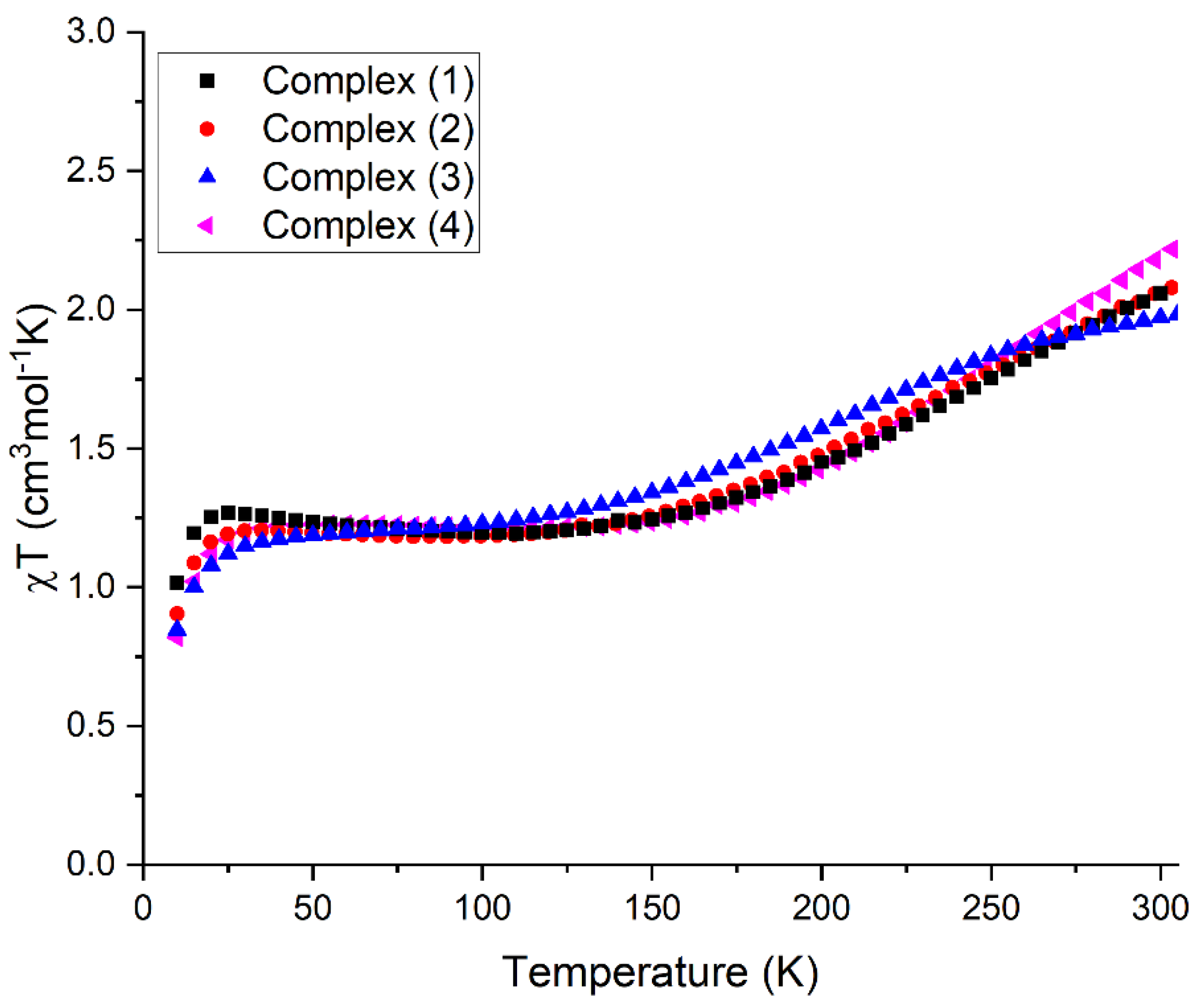



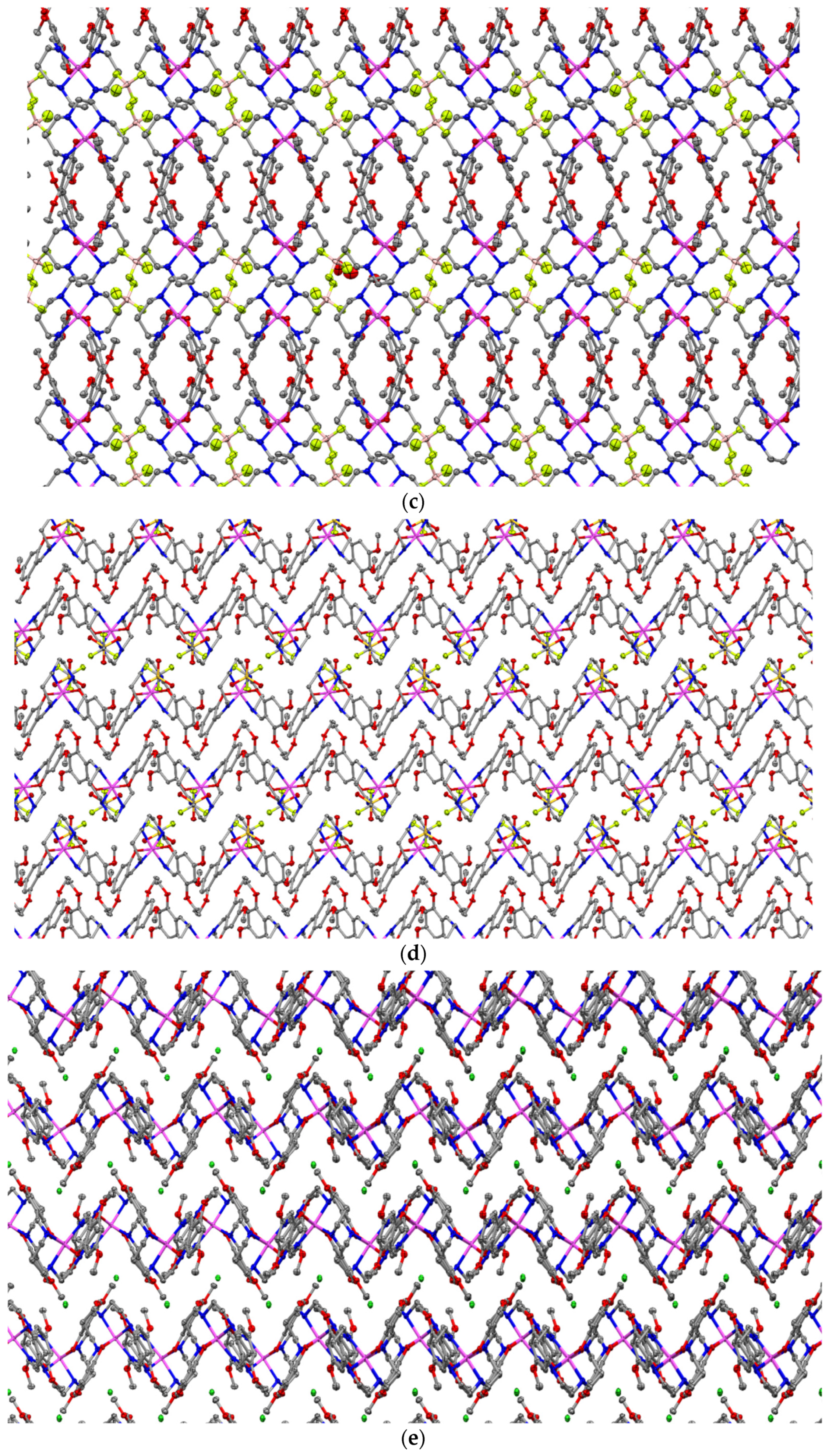

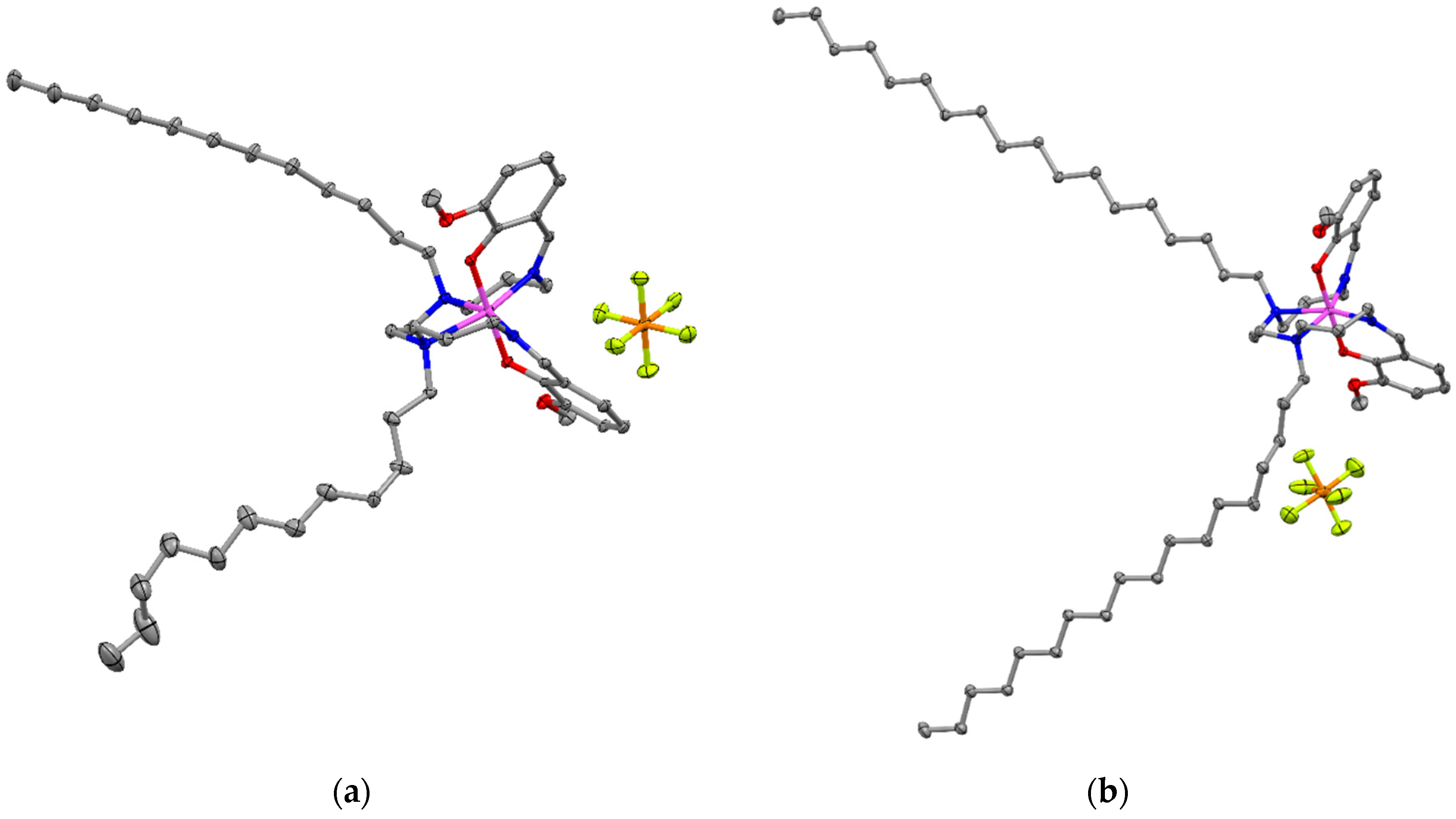
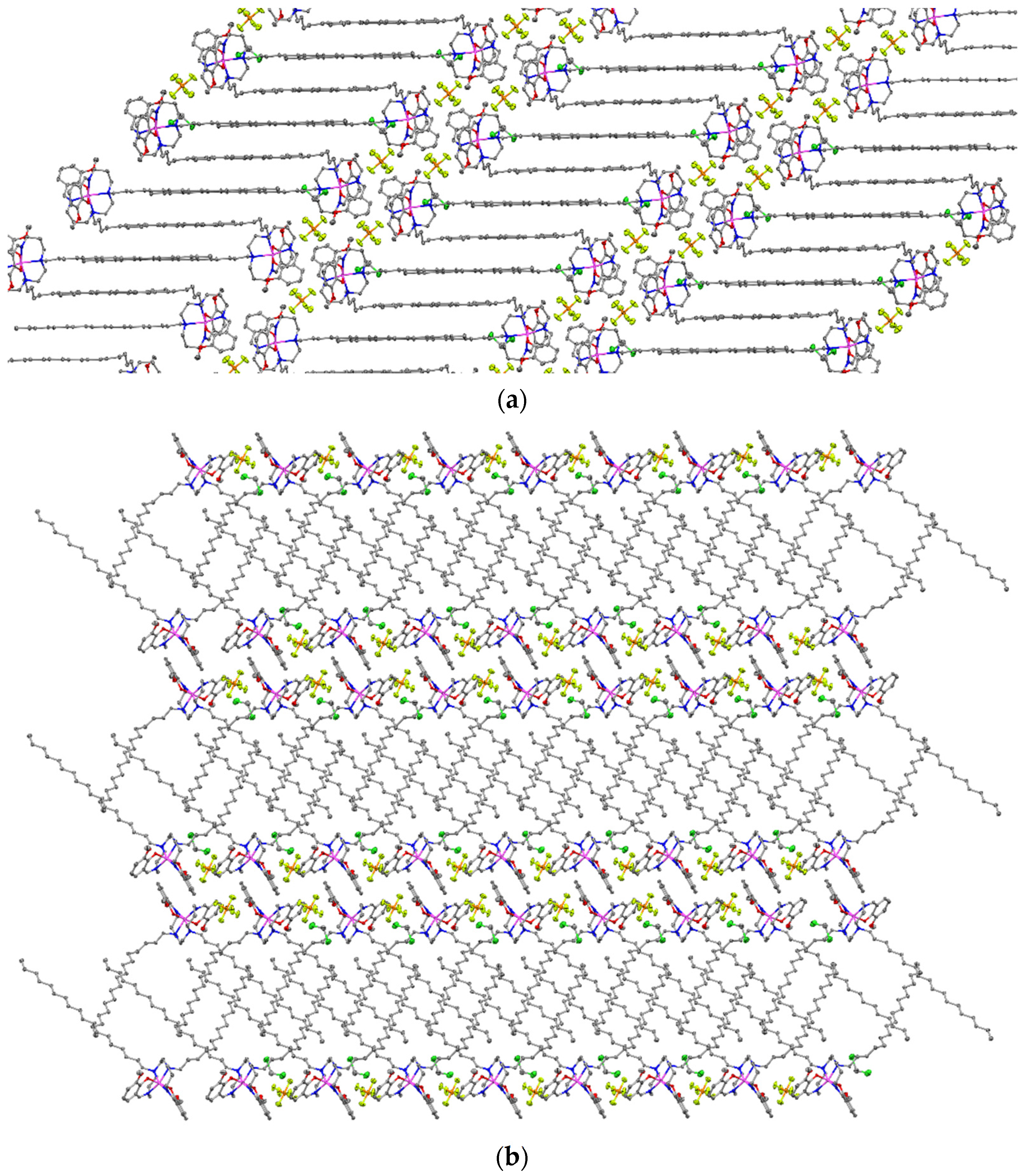
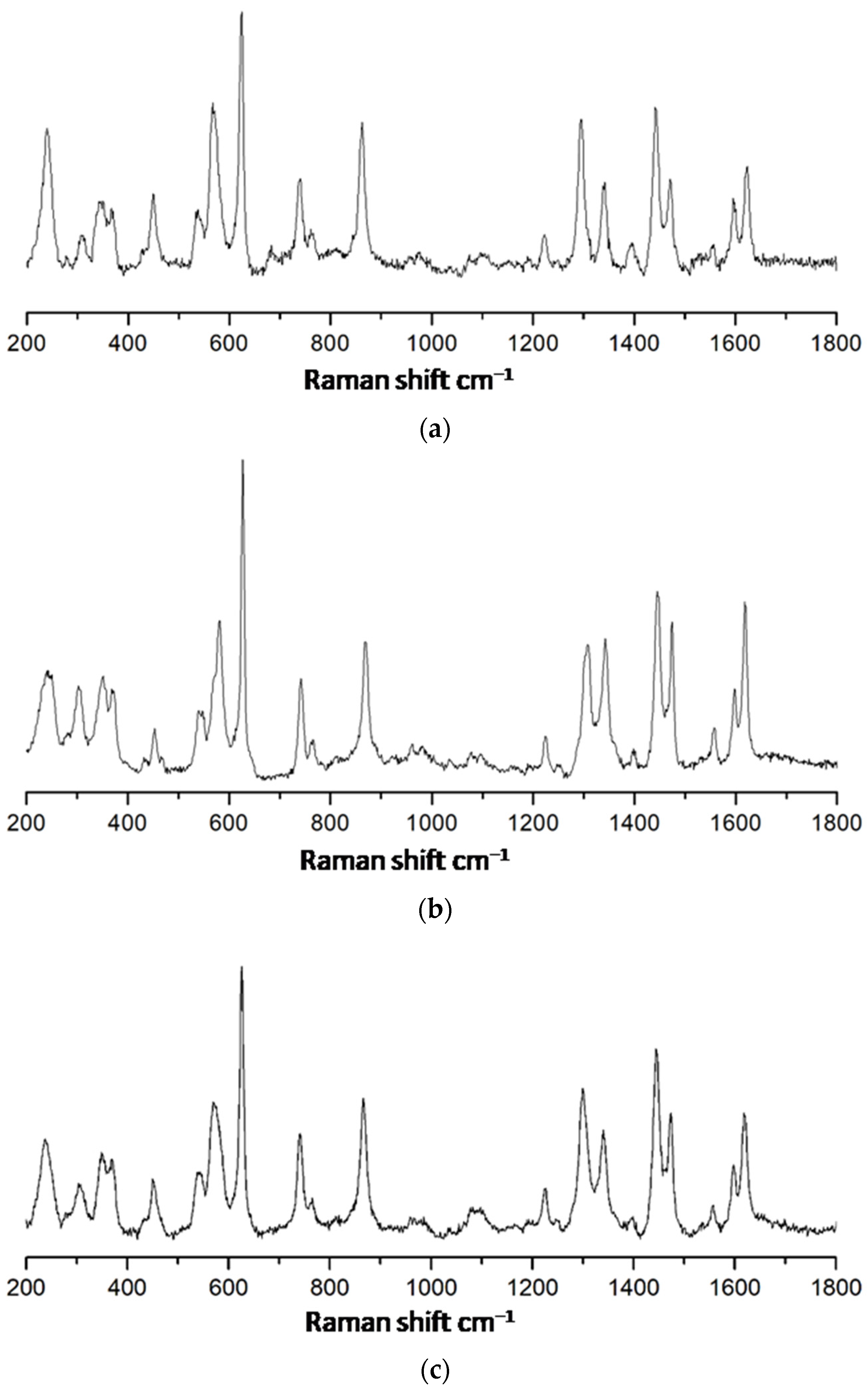
| Compound | Formula * |
|---|---|
| (1) * | [Mn(4,6-diOMe-sal2323)]ClO4·0.5H2O |
| (2) * | [Mn(4,6-diOMe-sal2323)]NO3·1.15H2O |
| (3) * | [Mn(4,6-diOMe-sal2323)]BF4·0.85H2O |
| (4) * | [Mn(4,6-diOMe-sal2323)]CF3SO3 |
| (5) * | [Mn(4,6-diOMe-sal2323)]Cl·C2H5OH |
| (6) * | [Mn(4,6-diOMe-sal2323-C6)](BF4)0.8(ClO4)0.2·2CH3OH |
| (7) * | [Mn(4,6-diOMe-sal2323-C12)]ClO4 |
| (8) | [Mn(4,6-diOMe-sal2323-C18)]ClO4 |
| (9) | [Mn(4,6-diOMe-sal2323-C22)]ClO4 |
| (10) * | [Mn(3-OMe-sal2323-C6)]PF6 |
| (11) * | [Mn(3-OMe-sal2323-C12)]PF6·CH3CN |
| (12) * | [Mn(3-OMe-sal2323-C18)]PF6·CH2Cl2 |
| Spin State | ∑ | Ѳ |
|---|---|---|
| S = 1 | 28–45° | 79–125° |
| S = 2 | 48–80° | 135–230° |
| (1) | (2) | (3) | (4) | (5) | |
|---|---|---|---|---|---|
| Mn-Ophen (Å) | 1.889 1.896 | 1.894 1.896 | 1.890 1.899 | 1.885 1.899 | 1.885 1.888 |
| Mn-Nimine (Å) | 1.976 1.985 | 1.987 1.987 | 1.980 1.985 | 1.982 1.981 | 1.979 1.989 |
| Mn-Namine (Å) | 2.053 2.054 | 2.054 2.057 | 2.057 2.057 | 2.057 2.058 | 2.040 2.054 |
| ∑ ° | 33.4 | 32.9 | 33.6 | 28.6 | 33.9 |
| Ѳ ° | 99.9 | 101.1 | 101.0 | 82.1 | 97.2 |
| Assignment | S = 1 | S = 1 | S = 1 | S = 1 | S = 1 |
| (6) | (7) | (10) | (11) | (12) | |
|---|---|---|---|---|---|
| Mn-Ophen (Å) | 1.860 1.864 | 1.866 1.867 | 1.857 1.861 | 1.857 1.859 | 1.861 1.872 |
| Mn-Nimine (Å) | 2.076 2.102 | 2.087 2.094 | 2.104 2.104 | 2.091 2.196 | 2.086 2.125 |
| Mn-Namine (Å) | 2.307 2.318 | 2.307 2.311 | 2.280 2.302 | 2.292 2.311 | 2.268 2.347 |
| ∑ ° | 58.8 | 58.2 | 64.2 | 61.7 | 65.8 |
| Ѳ ° | 246.2 | 241.6 | 250.4 | 233.0 | 239.5 |
| Assignment | S = 2 | S = 2 | S = 2 | S = 2 | S = 2 |
Publisher’s Note: MDPI stays neutral with regard to jurisdictional claims in published maps and institutional affiliations. |
© 2022 by the authors. Licensee MDPI, Basel, Switzerland. This article is an open access article distributed under the terms and conditions of the Creative Commons Attribution (CC BY) license (https://creativecommons.org/licenses/by/4.0/).
Share and Cite
Pandurangan, K.; Carter, A.B.; Martinho, P.N.; Gildea, B.; Lemma, T.; Shi, S.; Sultan, A.; Keyes, T.E.; Müller-Bunz, H.; Morgan, G.G. Steric Quenching of Mn(III) Thermal Spin Crossover: Dilution of Spin Centers in Immobilized Solutions. Magnetochemistry 2022, 8, 8. https://doi.org/10.3390/magnetochemistry8010008
Pandurangan K, Carter AB, Martinho PN, Gildea B, Lemma T, Shi S, Sultan A, Keyes TE, Müller-Bunz H, Morgan GG. Steric Quenching of Mn(III) Thermal Spin Crossover: Dilution of Spin Centers in Immobilized Solutions. Magnetochemistry. 2022; 8(1):8. https://doi.org/10.3390/magnetochemistry8010008
Chicago/Turabian StylePandurangan, Komala, Anthony B. Carter, Paulo N. Martinho, Brendan Gildea, Tibebe Lemma, Shang Shi, Aizuddin Sultan, Tia E. Keyes, Helge Müller-Bunz, and Grace G. Morgan. 2022. "Steric Quenching of Mn(III) Thermal Spin Crossover: Dilution of Spin Centers in Immobilized Solutions" Magnetochemistry 8, no. 1: 8. https://doi.org/10.3390/magnetochemistry8010008
APA StylePandurangan, K., Carter, A. B., Martinho, P. N., Gildea, B., Lemma, T., Shi, S., Sultan, A., Keyes, T. E., Müller-Bunz, H., & Morgan, G. G. (2022). Steric Quenching of Mn(III) Thermal Spin Crossover: Dilution of Spin Centers in Immobilized Solutions. Magnetochemistry, 8(1), 8. https://doi.org/10.3390/magnetochemistry8010008







